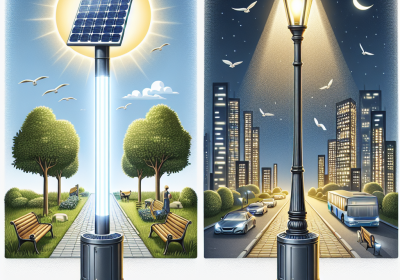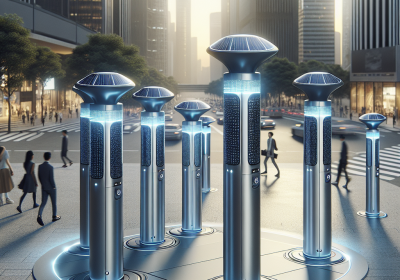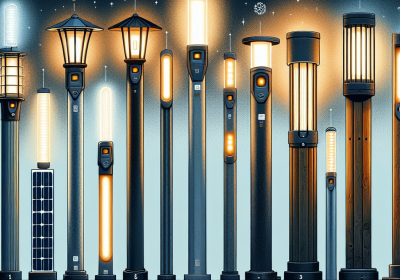Illuminating the Path: The Rise of Commercial Solar Bollards in Australian Landscapes
As cities across the globe pivot towards sustainable development, Australia is no exception, leading the charge with innovative green technologies. One such innovation that’s been lighting up our landscapes—both metaphorically and literally—is the solar bollard. But what makes these humble light posts stand out in the quest for eco-friendly solutions?
What Are Solar Bollards?

Definition and Description Solar bollards are self-sufficient lighting fixtures designed for outdoor environments. Unlike traditional lighting, these bollards operate independently of the electrical grid, harnessing the sun’s energy to offer illumination after dark.
Key Features of solar bollards
- Self-Contained Lighting: Each bollard is a standalone unit, which means no external wiring and reduced installation costs.
- Energy Efficiency: Solar bollards convert sunlight into electricity, minimizing energy consumption and operating costs.
Technological Components of solar bollards
- Solar Panels: These capture solar energy.
- LED Lighting: Efficient lights that use the stored solar power.
- Batteries: Store electricity for use during the night.
Evolution and Adoption of solar bollards in Australia
Historical Context The use of solar bollards in Australia began as part of a broader initiative to reduce public infrastructure’s carbon footprint. Initially seen in parks and along pedestrian paths, their popularity has only grown.
Drivers of Adoption
- Urban Growth: Expanding urban areas require more lighting, and solar bollards provide a scalable solution.
- Government Incentives: Subsidies and grants for renewable energy projects encourage the adoption of solar technologies.
Comparison to Traditional Lighting Traditional electric lights are costlier to extend due to the need for wiring and electrical work. Solar bollards, however, install with minimal disruption and ongoing cost.
Quick Facts and Insights
- Energy Efficiency Metrics: Solar bollards typically reduce electricity usage by up to 90% compared to traditional lighting, depending on the model and settings.
- Material Sustainability: Most solar bollards are constructed from materials like aluminum, which is fully recyclable, aligning with eco-friendly practices.
- Adoption Rates: In major Australian cities like Melbourne and Sydney, over 5,000 solar bollards have been installed in the past year, with a 20% increase projected annually.
- Smart Technology Integration: Newer models of solar bollards are equipped with IoT connectivity, allowing remote monitoring and data collection to optimize energy use.
- International Comparison: Countries like Germany and Canada are also embracing solar bollard technology, with adoption rates growing at a similar pace to Australia’s.
- Environmental Impact: Studies indicate that light pollution is significantly reduced with the use of solar bollards, benefiting local wildlife by mimicking natural moonlight rather than harsh artificial lighting.
Benefits of Solar Bollards
Environmental Benefits
- Reduced Carbon Footprint: Solar bollards use renewable energy, which significantly cuts down greenhouse gas emissions.
- Renewable Energy Use: They contribute directly to the use of sustainable energy sources in public infrastructure.
Economic Benefits
- Energy and Maintenance Savings: The sun provides free energy, and solar bollards require less maintenance due to fewer moving parts and no external wiring.
Safety and Aesthetic Enhancements of commercial solar bollards
- Increased Safety: Well-lit areas reduce the risk of accidents and deter crime.
- Visual Appeal: Solar bollards are designed to be aesthetically pleasing, enhancing the visual landscape of the areas they illuminate.
Community Impact Feedback from these communities has been overwhelmingly positive, citing improved night-time visibility and reduced energy bills.
Challenges and Limitations of solar bollards
Technical Challenges
- Energy Storage: Limited battery capacity can be a challenge during prolonged overcast weather.
- Efficiency Issues: Lower performance in winter months due to reduced sunlight.
Regulatory and Public Acceptance
- Compliance Issues: Meeting varying municipal standards can be challenging.
- Resistance: Some communities are hesitant to change, preferring traditional lighting solutions.
Practical Tips for Implementation and Maintenance of commercial solar bollards
- Selection Criteria: When choosing solar bollards, consider factors such as the intensity of LED lighting (measured in lumens), battery life expectancy, and product warranty.
- Optimal Placement: To maximize efficiency, place solar bollards in areas that receive direct sunlight for the majority of the day and avoid shaded areas caused by trees or buildings.
- Regular Maintenance: Clean the solar panels quarterly to remove dust and debris, and check battery health annually to ensure optimal performance.
- Vandalism Prevention: Install solar bollards with anti-tamper screws and consider protective casings in high-risk areas to extend their lifespan.
- Seasonal Adjustments: Adjust the angle of solar panels with the change of seasons to capture the optimal amount of sunlight, particularly in winter when the sun is lower in the sky.
- Community Engagement: Hold community forums and workshops to educate the public about the benefits of solar bollards and gather feedback for future installations.
Future Prospects
Technological Advancements Future innovations may include more efficient solar panels and batteries, enhancing the reliability and performance of solar bollards.
Government Incentives Potential increases in government support could spur wider adoption, making solar bollards a cornerstone of urban development.
Market Predictions As technology improves and costs decrease, solar bollards are expected to become a staple in urban and rural lighting plans across Australia.
Solar bollards are more than just a lighting solution; they are a testament to Australia’s commitment to sustainable development. As we continue to innovate, the integration of technologies like solar bollards will play a crucial role in shaping eco-friendly cities.
References
FAQs
Q1: How long do solar bollards last? A: Typically, solar bollards can last between 10-15 years depending on the quality of components used.
Q2: Are solar bollards weatherproof? A: Yes, most solar bollards are designed to be weather-resistant, suitable for various Australian climates.
Q3: What maintenance is required for solar bollards? A: Maintenance mainly involves cleaning the solar panels and checking the batteries periodically.
Q4: Can solar bollards be used in areas with severe weather conditions? A: Yes, but their efficiency might be reduced in extremely overcast or rainy conditions.
This article presents a comprehensive view of solar bollards, showcasing their benefits and the growing trend of their use in sustainable urban development across Australia.
Read more about commercial solar street lights
Eco-Friendly and Efficient: How Solar Bollards Are Shaping Australia’s Green Cities
Cost Analysis: The Long-Term Savings of Solar Bollards Over Traditional Lighting Solutions
Innovation in Illumination: The Latest Technologies in Solar Bollard Design
The Role of Solar Bollards in Australia’s Varied Climates
Regulatory Insights: Compliance and Standards for Installing Solar Bollards in Australia
Public Perception and Acceptance: Community Responses to Solar Bollards in Urban Areas
The Future of Outdoor Lighting: Predictions for Solar Bollards in the Next Decade









